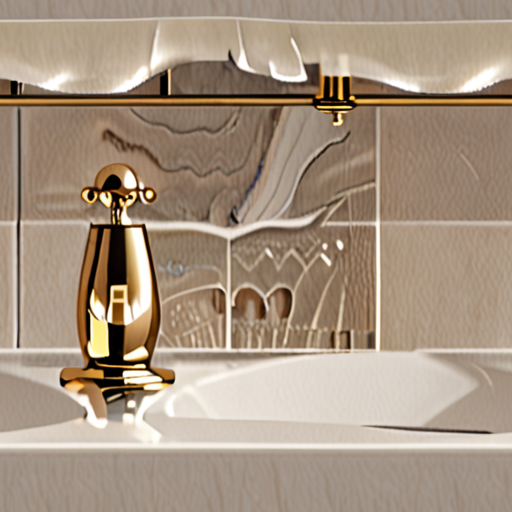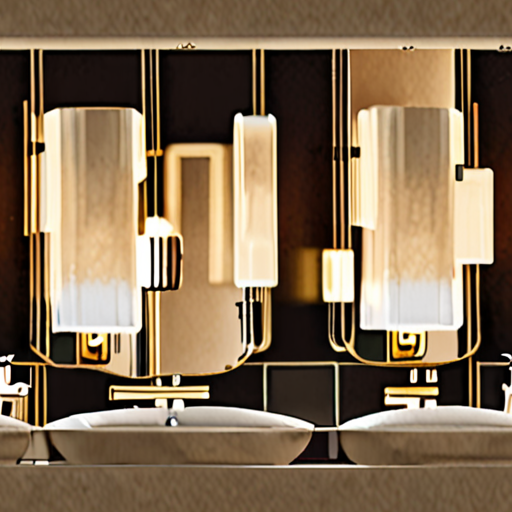Bathroom lighting plays a crucial role in transforming the overall ambiance and functionality of your space. Whether you’re aiming to create a relaxing retreat, enhance your grooming routine, or add a touch of elegance, the right bathroom lighting ideas can make all the difference. From selecting the best lighting options to ensuring proper placement and adhering to safety guidelines, this guide will walk you through everything you need to know to achieve the perfect bathroom lighting setup. Explore modern trends, specialized solutions for small spaces, and tips on integrating lighting seamlessly with your decor. Get ready to elevate your bathroom experience with expert advice on every aspect of bathroom lighting.

Bathrooms Require Thoughtful Lighting Choices
When it comes to selecting the best lighting for your bathroom, there are several factors to consider to ensure functionality, comfort, and aesthetic appeal. Here’s a breakdown of the key considerations:
- Recessed Lighting: Install recessed lights aimed toward the ceiling to reduce shadows and create a spacious feel. These lights are ideal for ambient lighting and can be integrated into your bathroom’s design seamlessly.
- LED Lighting: Energy-efficient LED bulbs are highly recommended due to their longevity and low power consumption. They provide bright, uniform light coverage and come in various color temperatures.
- Color Temperature:
- 3000K to 4000K: These ranges offer a spectrum that includes warm whites and cool whites. A 3000K bulb provides a softer, warmer light, perfect for tasks like shaving or applying makeup, while a 4000K bulb offers a cooler, brighter light suitable for general illumination.
- Task Lighting: Add lamps or wall-mounted fixtures for focused light where needed, such as near the mirror or sink. These can complement your main lighting source and enhance functionality.
- Ambient Lighting: Consider track lighting or pendant lights to create a welcoming atmosphere. Pendant lights can serve as a decorative element while providing sufficient illumination.
- Energy Efficiency: Prioritize LED bulbs for their energy-saving benefits and long lifespan. Look for bulbs with high CRI (Color Rendering Index) for better skin tone accuracy.
- Light Placement and Control: Ensure lights are placed strategically to avoid shadows. Use dimmers to adjust brightness levels according to your preferences, whether you’re getting ready in the morning or relaxing in the evening.
- Safety Considerations: Make sure your bathroom lighting is adequate for tasks requiring precision, such as shaving or applying makeup, and avoid harsh lighting that may cause glare.
Combining these elements will help you create a bathroom environment that is both functional and visually appealing. Consider consulting a lighting professional for personalized recommendations tailored to your space’s unique needs.
General Rule for Lighting in a Bathroom
Bathrooms require careful consideration of lighting to ensure functionality, safety, and aesthetic appeal. Here’s a comprehensive guide to follow:
- Damp-Rated Fixtures: Any lighting fixtures in a bathroom must be damp-rated to prevent damage from moisture. Areas above showers, near sinks, or in wet zones require fixtures rated for wet conditions.
- Zoning by Function:
- Main Area: Use recessed ceiling lights or wall-mounted fixtures to provide ambient lighting without glare.
- Task Lighting: Install wall sconces or pendant lights near mirrors for focused illumination.
- Shower or Bathtub Areas: Consider using spotlights, showerhead lights, or built-in bath fixtures for targeted lighting.
- Near Windows: Use sheer curtains or diffused lighting to prevent harsh sunlight from disrupting the space.
- Light Bulb Choice: Opt for energy-efficient LEDs or warm-toned bulbs for a relaxing atmosphere. Cool-toned bulbs can enhance brightness in certain areas.
- Placement and Reflection: Avoid placing lights directly above mirrors to reduce glare. Position sconces at eye level for optimal task lighting.
- Layered Lighting: Combine ambient, task, and accent lights for a balanced look. Use decorative elements like lanterns or wall art for added ambiance.
For more expert tips and design inspiration, explore our Bathroom Lighting Design Guide .

Where Should Lights Be Placed in the Bathroom?
Lighting plays a crucial role in creating a functional and aesthetically pleasing bathroom environment. Here’s a guide to strategically placing lights in your bathroom:
- Mirror Area: Install lighting above the mirror, such as a wall-mounted fixture or a pendant light, to ensure adequate illumination for tasks like shaving or applying makeup. Consider using mirror lighting solutions for optimal reflection.
- Sink Area: Place task lighting, such as a wall-mounted sconce or a recessed fixture, above the sink for focused lighting during grooming activities. Opt for fixtures with a frosted lens to minimize glare.
- Toilet Area: Use ambient lighting, such as recessed ceiling cans or wall-mounted fixtures, to create a soothing atmosphere without overpowering brightness. These lights should be low-voltage to ensure a restful environment.
- Shower Area: Install LED strip lights along the shower walls for a subtle, moisture-resistant lighting option. These can be dimmed for a calming ambiance during showers.
- Bathroom Entrance: Consider adding motion-activated lights near the bathroom door to provide automatic illumination as you enter, enhancing safety and convenience.
When choosing bathroom lighting, prioritize energy efficiency by selecting LED fixtures, which consume less power and last longer than traditional bulbs. Always ensure that lighting fixtures are placed safely away from water sources and are suitable for damp environments. By thoughtfully arranging these elements, you can create a bathroom that is both functional and visually appealing.

What Lights Are Suitable for Bathrooms?
Bathrooms require specific lighting solutions due to their moist and humid environment. Here are the most suitable types of lighting for bathrooms:
- Recessed Ceiling Lights : These are a popular choice as they provide ambient lighting without protruding into the room. Ensure they are specifically designed for bathroom use with an IP rating of at least 67.
- Wall Sconces : Surface-mounted lights that offer task lighting, ideal for areas like mirrors or sinks. Look for models rated IP67 for moisture resistance.
- LED Strip Lighting : Flexible and durable, these can be installed along mirrors or shower enclosures. Many are designed for bathroom use with IP67 ratings.
- Mirror Lighting : Built-in or attached lighting within the mirror frame, typically featuring LED technology, designed for bathroom environments.
- Bathroom Fan Lights : Some fans come with integrated lighting, perfect for tasks like shaving or applying makeup, and are built to withstand damp conditions.
Considerations:
– **IP Rating**: Ensure all lights have an IP rating of at least 67 to protect against immersion, splashes, and high humidity.- **Bulbs**: Use low-voltage bulbs for safety and LED or CFL bulbs for energy efficiency and long lifespan.- **Installation**: Recessed lights may require specialized installation, while wall sconces are generally easier to install.- **Energy Efficiency**: Opt for LED lights for reduced energy consumption and lower heat emission.By selecting the right combination of these lighting options and considering installation and energy efficiency, you can create a functional and stylish bathroom environment.
Code for Bathroom Lighting
The code for bathroom lighting typically involves several electrical requirements to ensure safety and functionality. Here’s a breakdown of the essential aspects:1. **Circuit Requirements**: – A 20-amp circuit is generally recommended for bathroom lighting. This circuit can support both the overhead light and an exhaust fan. – For more advanced setups, such as heated mirrors or towel warmers, a 30-amp circuit may be preferable.2. **Grounding**: – Proper grounding is crucial. All electrical fixtures in the bathroom must be grounded to prevent shocks and potential fires.3. **Light Fixtures**: – Ensure that all light fixtures are rated for damp environments, as bathrooms are prone to moisture.4. **Exhaust Fans**: – Exhaust fans often share the same circuit as the lighting. Proper ventilation is important to prevent mold growth and odors.5. **Additional Features**: – If you plan to install features like a shaving lamp or mirror heating, consult a licensed electrician to determine the correct circuit and wiring needed.For the best results, we recommend referring to our comprehensive guide on bathroom remodeling electrical requirements: [Bathroom Electrical Safety Guide](https://peckandgartner.com/bathroom-electrical-safety-guide).Always hire a qualified electrician to handle bathroom lighting installations to ensure compliance with local building codes and safety standards.
Bathroom Lighting: Daylight vs. Bright White Bulbs
Choosing between daylight and bright white bulbs for your bathroom can depend on your preferences and the intended use of the space. Here’s a breakdown:
- Daylight Bulbs: These bulbs emit cooler tones, resembling natural light, making them ideal for tasks requiring precision, such as applying makeup or shaving. They provide better color accuracy and are often recommended for focused lighting in areas like kitchens and bathrooms.
- Bright White Bulbs: These bulbs emit warm light, creating a more inviting atmosphere. They are perfect for setting a relaxed mood, especially in the mornings, though they may not be as effective for detailed tasks due to their warmer tone.
Consider your personal preference and the ambiance you want to create. Daylight bulbs are better for task lighting, while bright white bulbs offer a cozy feel. Both options are available in various color temperatures and energy efficiencies, allowing you to find the best fit for your bathroom’s needs.




0 Comments